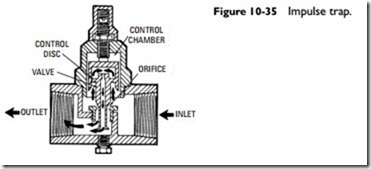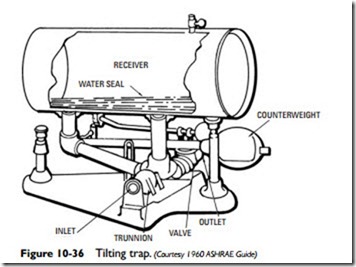Tilting Traps
The operation of a tilting trap (see Figure 10-36) is intermittent in nature. With this type of trap, condensation enters a bowl and rises until its weight overbalances that of a counterweight, and the bowl sinks to the bottom. As the bowl sinks, a valve is opened, thus admitting live steam pressure on the surface of the water, and the trap then discharges. After the water is discharged, the counter- weight sinks and raises the bowl, which in turn closes the valve, and the cycle begins again.
Lifting Traps
A lifting trap (see Figure 10-37) is an adaptation of the upright bucket trap and is available for pressures ranging from vacuum to 150 psig.
Condensation in the chamber of the trap accumulates until it reaches a level high enough to cause the steam valve in the high- pressure inlet to open. Steam then enters the auxiliary high-pressure inlet on the top of the trap at a pressure higher than the trap inlet pressure. This high-pressure steam forces the condensation to a point above the trap and against a back pressure higher than that which is possible with normal steam pressure. As the condensation is pushed out of the trap, the float or bucket descends to the bottom and causes the valve in the high-pressure inlet to close, shutting off the steam supply. Condensation then begins to refill the float chamber, and the cycle is repeated.

